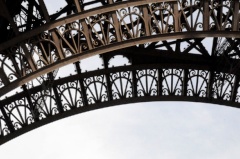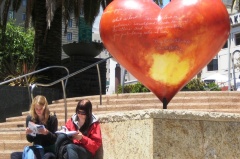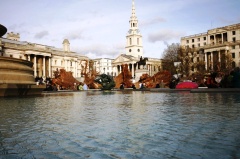10 Most Photographed Places on Earth
No. 10: Amsterdam
Landmark: Dam Square
Created in the 13th century as a dam around the Amstel River, this expansive plaza is now flooded with street performers and tourists (and pigeons). It's hard to capture the frenzied feeling in a wide shot.
Standard shot: Wide, with buildings and lots of space
Tip: Try keeping other people in the frame. There's a natural temptation to shy away from shooting photos of strangers, but including people can give viewers a contextual clue about the relative size of the subject you're photographing. Plus families and groups of travelers can make a space seem more alive. Here, the photographer has used the plaza as a backdrop to capture its local talent.

No. 9: Rome
Landmark: Colosseum
This ancient site is filled with the ghosts of dueling gladiators, tormented prisoners, and slaughtered animals, contained, centuries after the fact, within a stunning framework of Corinthian, Doric, and Ionic columns. It's a gorgeous dichotomy indeed, and it's hard to not want to capture it all.
Standard shot: The structure, in its entirety.
Tip: Take advantage of a natural "frame." The archways at Rome's Colosseum give shape to the photo. Shooting through windows, courtyards, doorways, and other openings can create an appealing inside/outside dynamic.

No. 8: Seattle
Landmark: Space Needle
What began as the symbol of the World's Fair in 1962 has now become the symbol of this supercool city. The 360-degree view from the top is expansive, taking in sights from the Puget Sound to Mount Rainier.
Standard shot: From directly below.
Tip: Create a mirror image. Reflective surfaces are common in urban areas. For a unique take on a classic monument, look around for how an object might be mirrored in a car window, a building's glass front, or the surface of a fountain.

No. 7: Washington, D.C.
Landmark: Lincoln Memorial
This marble memorial to the 16th president—featuring Ionic columns, oil-paint murals, and a 120-ton statue of Abe himself—is a striking part of the National Mall.
Standard shot: The full building, from a distance.
Tip: Put things in "perspective." A straight-on shot is the most obvious one to take of the Lincoln Memorial, as it puts the main subject front and center. But including other objects in the picture, like this $5 bill, adds a creative element of whimsy to what might otherwise be a dime-a-dozen postcard image.

No. 6: Chicago
Landmark: Cloud Gate sculpture
Anish Kapoor's 110-ton bean of stainless steel is the shiny centerpiece of Millennium Park's AT&T Plaza and makes for a striking photo in just about any composition.
Standard shot: A direct shot of the bean, taken from the side.
Tip: Avoid the obvious. Whether it's a sculpture, a person, or a building, you can always walk around your subject to get a different view. In this case, the photographer went underneath the bean sculpture—made of highly polished steel and inspired by liquid mercury—and shot upward for a truly unique view.

No. 5: Los Angeles
Landmark: Hollywood Walk of Fame
Begun in 1960 as a Hollywood marketing tool (with filmmaker Stanley Kramer the first honoree), the series of coral-colored stars was at 2,441 in May 2011 and continues to grow.
Standard shot: One star, shot from above.
Tip: Use distance as a frame of reference. Rather than rush in and snap away, pre-visualize your image, thinking about how to photograph a subject from different directions. In this case, the photographer chose to present the stars in a line—a decision that brings context to the shot.

No. 4: Paris
Landmark: Eiffel Tower
Gustave Eiffel's 1889 masterpiece, constructed in celebration of the French Revolution's 100th anniversary, is magnificent at any angle; but why choose one that you can easily find on a postcard?
Standard shot: Full-on, from far away.
Tip: Keep an eye out for unexpected patterns. Most pictures of the Eiffel Tower are taken from a distance. But its detailed iron latticework also captures attention. In general, close-up shots of patterns in architecture help a viewer see iconic attractions with fresh eyes.

No. 3: San Francisco
Landmark: Union Square
The main downtown plaza—used as a rallying site to support troops during the Civil War—is now a mecca for hardcore shopping and people-watching. It's also a great place to hop aboard a cable car.
Standard shot: A wide-angle view of Union Square from the Macy's Building.
Tip: Less is more. A close-up photo can sometimes be as powerful as a wide-angle one. As Belgian fashion designer Dries Van Noten once said: "It's more interesting to have just a picture of a small detail. Then you can dream all the rest around it." Here, a tight shot of a sculpture in the square takes that advice to heart.

No. 2: London
Landmark: Trafalgar Square
John Nash designed and developed this former palace courtyard into a public space in the early 1800s; it has since been further transformed with sculptures, fountains, and staircases, and has become a local hotspot for protests—all worthy subjects for your lens.
Standard shot: A wide-angle shot of the National Gallery and St. Martin-in-the-Fields church.
Tip: Shift direction. Tilt your lens down to get some surprising texture in the foreground of your shot. Here, the photographer juxtaposed an urban icon, St. Martin-in-the-Fields church, with the surface of a Trafalgar Square fountain. (And, in case you were curious, the tree stumps in this photo were part of an exhibition that warned about deforestation.)

No. 1: New York
Landmark: Empire State Building
Built in one year and 45 days in the midst of the Great Depression, this iconic skyscraper draws about 3.5 million visitors a year to its observatories. On a clear day, you can see as far as Massachusetts, but backward glances at the soaring architecture are pretty seductive, too.
Standard shot: The view of the Empire State Building from the street below.
Tip: Broaden your perspective. Photographing an expected sight from an unexpected place can add a lot to your photo. To get this shot, head 16 blocks north and up 70 floors to the Top of the Rock Observation Deck in Rockefeller Center, where you'll get the best view of the Empire State Building—along with a 360-degree panorama of the city.